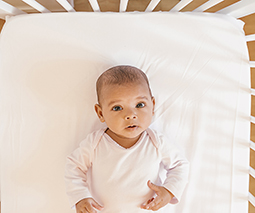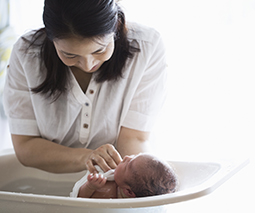How to introduce a feed-play-sleep rhythm to your baby’s day

Despite what all parents hope for, most young babies don’t naturally fall into a daily rhythm without a little bit of help from Mum and Dad.
Mothercraft nurse, Chris Minogue has some simple suggestions and advice to help new parents get their baby into a daily rhythm that will keep everyone well rested and happy.
Rhythm vs routine
First we need to understand what a daily ‘rhythm’ is exactly – because it’s not the same as a routine.
“Unlike a routine, a rhythm isn’t set by time,” Chris explains. “It’s set by what happens within the window of the baby being awake.”
Because for the first couple of months of life your baby is still developing sleeping patterns that differentiate day and night, each day can start at a different time, which makes trying to introduce a routine – for example, up at 6:30am, breakfast and play, then down again at 8:30am – impractical and usually unachievable.
So it is better to concentrate on developing a rhythm instead, that creates a flow of activities each time your baby is awake.
The feed-play-sleep rhythm usually doesn’t occur until your baby is between five and six weeks old. “Up until then, they’re in a feed-sleep rhythm … when they’re still in the sleepy phase of a newborn. Then a feed-alert-sleep rhythm around three weeks when they hold their eyes open and start looking around,” says Chris.
The feed/play/sleep rhythm is a transitory phase that will naturally disappear around 12 to 16 weeks as your baby begins to develop a more regular pattern of behaviour and needs less sleep during the day. At this age, your baby will develop a feeding pattern and a sleeping pattern.
Until that happens though, the feed-play-sleep rhythm can really work to keep order and calm to the day.

Why feed-play-sleep?
A common rhythm that parents often follow is play-feed-sleep, or even, feed-play-feed-sleep, but this order of events often introduces the habit of feeding baby to sleep, “which in the long term becomes a difficult pattern of behaviour, because it means that every time the baby wakes, they will need a feed to go to sleep,” says Chris. “So we are trying to turn that pattern around.”
1. Feed
Feeding your baby after sleep makes sense because they often wake hungry and are less likely to engage with gentle play during their alert period if they have an empty belly.
2. Play
Even in a young baby, play is central to their learning and development. Not only does play help develop fine and gross motor skills, but it also helps develop social skills and curiosity about the world around them.
For babies, the best toy is you – so give them plenty of time in your arms to look at your face, listen to your voice and watch your smiles.
It’s also important to introduce tummy time and floor play at a young age as this helps develop muscle control and strength. To make this time enjoyable, you can get down on the floor with your baby and entertain him with age-appropriate toys. Brightly coloured squeakers and rattles like the Playgro Jungle Squeaker are perfect – made for little hands, the soft fabric toy features bright colours and bold patterns for visual stimulation.
Fisher-Price Grow-with-Me Tummy Time Llama is also perfect for the job – it provides a snuggly soft toy for your growing baby. The plush wedge supports your baby as he grows, from lying on his back to pushing up in tummy time, sitting up to play, and then playing on the go.
3. Sleep
After a period of active play, your baby will begin to disengage with the activity and become tired. This may happen quite quickly when your baby is very young, so keep an eye out for any tired signs and jump into action before he becomes overtired, which will make him harder to settle to sleep.
Swaddling him before bed will help him settle more quickly for sleep. You can ensure your bub has a safe and soothing sleep with the Love To Dream Swaddle Up. This zip up swaddle has patented wings that allows your baby to sleep in a natural position with their arms up to access their hands for true self-soothing.
Daytime to night-time
One of the merits of introducing this regular daily rhythm is that overnight, you can omit the play portion and move to a feed-sleep rhythm instead. And this is the very beginning of forming their day-night sleeping patterns.
“Because they’re in feed-play-sleep in the day,” Chris explains, “babies tend to sleep a little bit more soundly and a little bit longer at night. And the parents start to see the pattern of day-night behaviour occurring.”
Which means that one day, not too far from here, your baby will begin to sleep the whole night through. An amazing thought, right?
This is a sponsored post for BIG W, where you can find everything you need for pregnancy, baby and beyond.










